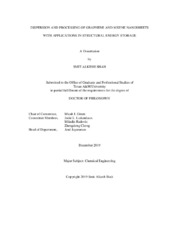| dc.description.abstract | Two-dimensional (2D) nanomaterials are unique for their high surface-to-volume ratio and high aspect ratio making them useful in a range of applications. Graphene and MXenes are such 2D nanosheets and have great potential in applications such as polymer composites, electrochemical energy storage electrodes in batteries and supercapacitors, and conductive inks. Improvements to existing lab-scale synthesis and processing techniques are crucial to serve the high demand of graphene and MXene nanosheets and make their applications commercially viable. In this study, various aspects of exfoliation, dispersion and processing of pristine graphene are investigated. A facile washing process was developed to recover graphene entrapped in the sediment to improve the overall yield of liquid phase exfoliated graphene (graphene/unexfoliated parent material). The total amount of graphene obtained through this approach increases with cumulative solvent volume. Graphene quantum dots (GQD) with sulfonyl, amine, and carboxylic functional groups were employed to exfoliate and disperse pristine graphene nanosheets in water. Sulfonyl functionalized GQD are able to disperse highest concentration of graphene in water compared to other functional groups. The results are consistent with a prior finding by pyrene and indicate that π- π stacking interaction between polyaromatic hydrocarbons (PAH) and graphene nanosheets and their role in dispersing graphene nanosheets are general across a wide range of PAH sizes and species. 2D flat Tiv3Cv2TX MXene nanosheets were processed for the first time in a spray dryer to scroll, bend, and fold them in to three-dimensional (3D) crumpled structures. This was the first experimental demonstration proving computational predictions that 2D MXene nanosheets can exist in a scrolled morphology. 3D graphene oxide (rGO) hydrogels were fabricated using colloidal self-assembly for application as supercapacitor electrodes due to their excellent specific surface area, high porosity, and electrically conductive continuous network. High-strength, Kevlar-derived aramid nanofibers (ANF) were employed as a reinforcing filler to improve the shear modulus of rGO hydrogels. This work will pave the way for further research to design and fabricate nanosheet based electrode architectures with controlled morphology and reinforcement with structural fillers to develop load-bearing multifunctional energy storage devices. | en |


